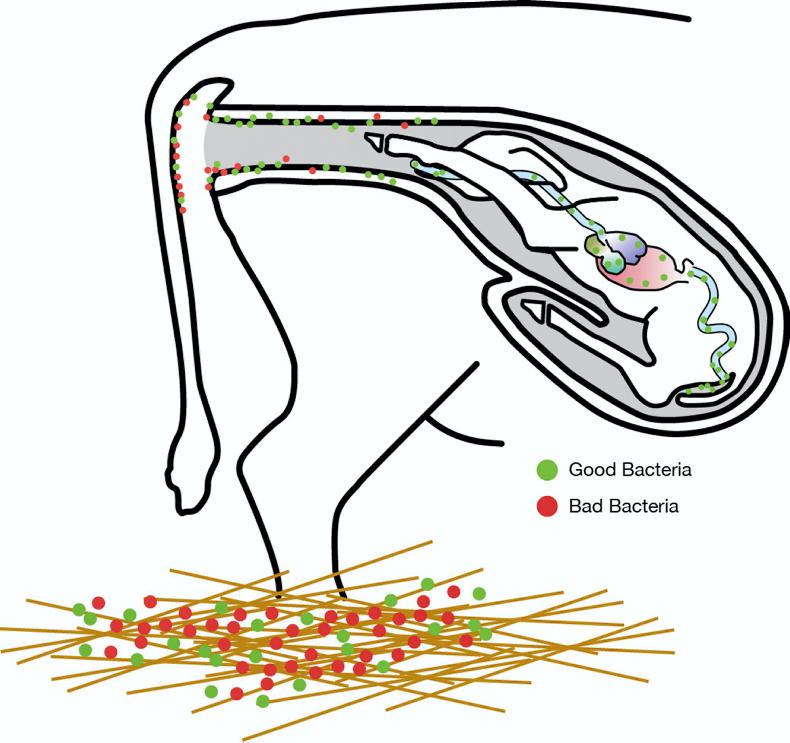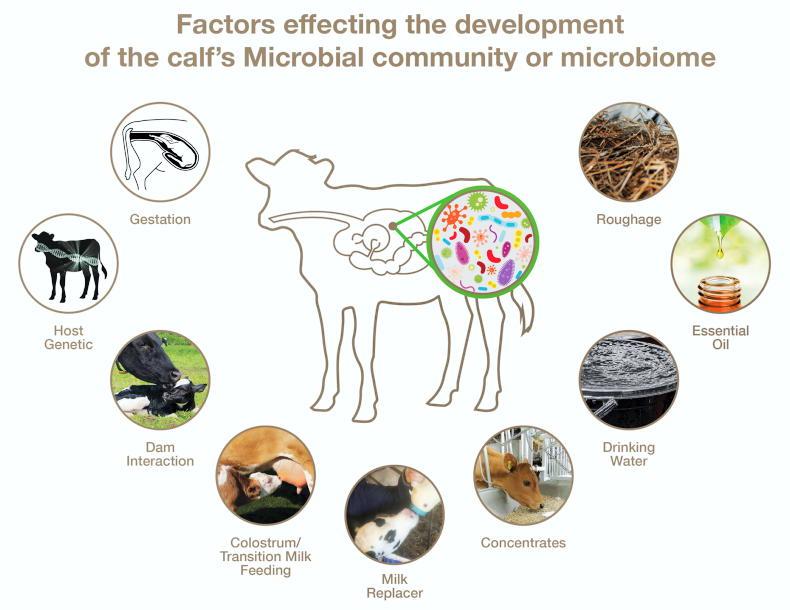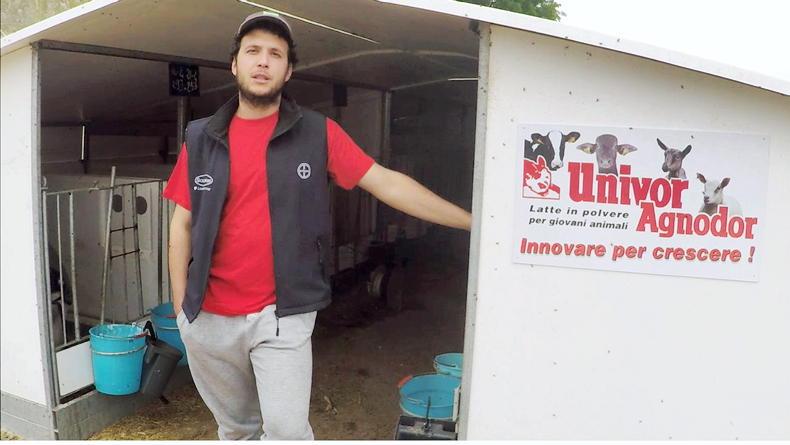
Microbes can be detected in an unborn calf’s digestive system 4 months before birth
Calves are born with a microbial community, otherwise known as the microbiome, already in place; it can be detected months before a calf is even born.

Bonanza Native Article
This microbiome is influenced from the very beginning by the genetics of the dam and calf, the calving process and the feeding of colostrum and transition milk. Prebiotics in colostrum help kickstart the calf’s digestive and immune system, followed by transition milk.
Feeding a good-quality milk replacer will help develop the calf’s digestive system and its microbiome because that microbiome responds to milk feeding, even to the quality of water offered.
The microbiome can be made up of over 900 different types of microbes producing tens of thousands of enzymes, essential fatty acids, vitamins and hormones.
It is well known that the use of waste milk containing antibiotics, or giving antibiotics in general, undermine and reduce the diversity of the microbiome, says Dr Christine Cummins of Bonanza Calf Nutrition.
“The microbes in the rumen are in balance even at two weeks of age and respond at first to increased fibre consumption but more slowly to starch intake,’’ she explains.
The microbes in the calf’s gut change over time to respond to fibre and starch consumption in the dry feed; these are mostly responsible for how starch is digested in the small and large intestines.
It takes time for the microbial population to change from those that digest most of the lactose - the lactobacilli - to bacteria that can utilise starch. It is estimated that one third of the starch fed to calves is potentially digested in the small and large intestines.
This is the reason why calves fed high levels of milk require much longer rearing periods, says Dr Cummins.
“If calves are offered 900g+ of milk solids, the weaning process will take four weeks or more. Therefore, calves should be fed milk until 12 weeks or more.’’
When calf growth is pushed with milk solids, weight is increased, but so too is reliance on lactobacilli.

Giovanne Mazzeti is one of the many satisfied Italian farmers using the Shine Once-a-day formula.
A calf that is weaned over one to two weeks will eat a lot of dry feed, but its rumen can’t utilise it; the small intestine also struggles and this leads to inflammation in the gut and any benefit from extra milk feeding is lost, and that is expensive and wasteful, says Dr Cummins.
“Also, what must not be ignored is that in systems in which a calf is suckling the dam, the cow will produce only 10 to 12 litres of milk after four to six weeks and that calf is weaned at six to eight months. Milk replacer systems are trying to mirror that in eight weeks.’’
Dr Cummins points out that there is another approach and that is to start reducing milk feeding frequency from four weeks of age.
Calves prefer to drink 60% of ad-lib intake in the morning feed, so moving to once a day milk feeding at this stage will keep calves happier.
“This will also encourage more dry feed intake and help develop the correct microbiome for forage and concentrate utilisation. It can also positively influence longevity and protect calves from becoming over-fat, a factor which could reduce longevity.’’
A better and more cost effective method is to do as the cow does naturally and that is to offer the calf about 2% of its birthweight (600g to 900g) in milk solids, Dr Cummins adds.
By holding the feeding rate constant, the calf can be encouraged to eat more concentrates from an earlier age
And by moving to once-a-day feeding and then to reducing the feed volume before finally weaning, growth checks at weaning can be eliminated and the calf’s health protected, maximising its potential whether it’s a beef or dairy animal.
Dr Cummins says there are no magic ingredients, secret formulas or feeding regimes with calf nutrition and, while it might seem logical that more is better, digestive systems are complex.
“By weaning earlier than a cow in nature would, it is very important that milk, concentrates, water and forage are used in tandem,’’ she says.

Microbes can be detected in an unborn calf’s digestive system 4 months before birth
Calves are born with a microbial community, otherwise known as the microbiome, already in place; it can be detected months before a calf is even born.

Bonanza Native Article
This microbiome is influenced from the very beginning by the genetics of the dam and calf, the calving process and the feeding of colostrum and transition milk. Prebiotics in colostrum help kickstart the calf’s digestive and immune system, followed by transition milk.
Feeding a good-quality milk replacer will help develop the calf’s digestive system and its microbiome because that microbiome responds to milk feeding, even to the quality of water offered.
The microbiome can be made up of over 900 different types of microbes producing tens of thousands of enzymes, essential fatty acids, vitamins and hormones.
It is well known that the use of waste milk containing antibiotics, or giving antibiotics in general, undermine and reduce the diversity of the microbiome, says Dr Christine Cummins of Bonanza Calf Nutrition.
“The microbes in the rumen are in balance even at two weeks of age and respond at first to increased fibre consumption but more slowly to starch intake,’’ she explains.
The microbes in the calf’s gut change over time to respond to fibre and starch consumption in the dry feed; these are mostly responsible for how starch is digested in the small and large intestines.
It takes time for the microbial population to change from those that digest most of the lactose - the lactobacilli - to bacteria that can utilise starch. It is estimated that one third of the starch fed to calves is potentially digested in the small and large intestines.
This is the reason why calves fed high levels of milk require much longer rearing periods, says Dr Cummins.
“If calves are offered 900g+ of milk solids, the weaning process will take four weeks or more. Therefore, calves should be fed milk until 12 weeks or more.’’
When calf growth is pushed with milk solids, weight is increased, but so too is reliance on lactobacilli.

Giovanne Mazzeti is one of the many satisfied Italian farmers using the Shine Once-a-day formula.
A calf that is weaned over one to two weeks will eat a lot of dry feed, but its rumen can’t utilise it; the small intestine also struggles and this leads to inflammation in the gut and any benefit from extra milk feeding is lost, and that is expensive and wasteful, says Dr Cummins.
“Also, what must not be ignored is that in systems in which a calf is suckling the dam, the cow will produce only 10 to 12 litres of milk after four to six weeks and that calf is weaned at six to eight months. Milk replacer systems are trying to mirror that in eight weeks.’’
Dr Cummins points out that there is another approach and that is to start reducing milk feeding frequency from four weeks of age.
Calves prefer to drink 60% of ad-lib intake in the morning feed, so moving to once a day milk feeding at this stage will keep calves happier.
“This will also encourage more dry feed intake and help develop the correct microbiome for forage and concentrate utilisation. It can also positively influence longevity and protect calves from becoming over-fat, a factor which could reduce longevity.’’
A better and more cost effective method is to do as the cow does naturally and that is to offer the calf about 2% of its birthweight (600g to 900g) in milk solids, Dr Cummins adds.
By holding the feeding rate constant, the calf can be encouraged to eat more concentrates from an earlier age
And by moving to once-a-day feeding and then to reducing the feed volume before finally weaning, growth checks at weaning can be eliminated and the calf’s health protected, maximising its potential whether it’s a beef or dairy animal.
Dr Cummins says there are no magic ingredients, secret formulas or feeding regimes with calf nutrition and, while it might seem logical that more is better, digestive systems are complex.
“By weaning earlier than a cow in nature would, it is very important that milk, concentrates, water and forage are used in tandem,’’ she says.









 This is a subscriber-only article
This is a subscriber-only article





